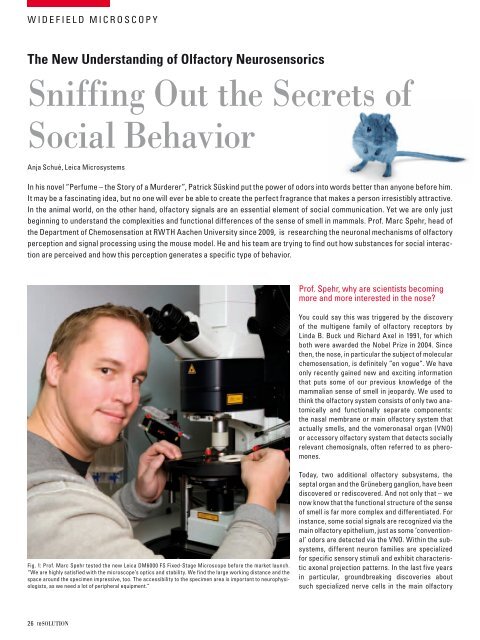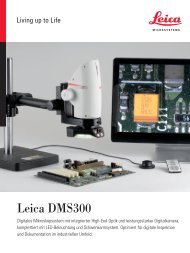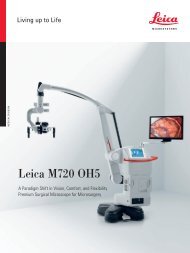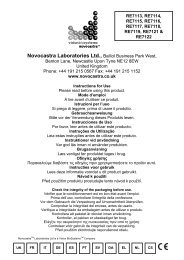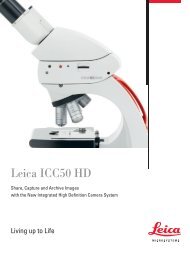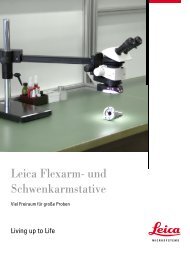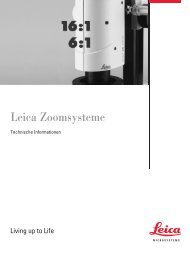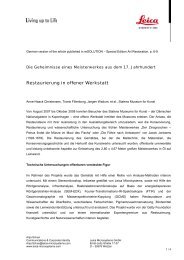reSOLUTION_Research_09_Neuroscience - Leica Microsystems
reSOLUTION_Research_09_Neuroscience - Leica Microsystems
reSOLUTION_Research_09_Neuroscience - Leica Microsystems
Create successful ePaper yourself
Turn your PDF publications into a flip-book with our unique Google optimized e-Paper software.
Widefield microscoPy<br />
The New Understanding of Olfactory Neurosensorics<br />
sniffing out the secrets of<br />
social Behavior<br />
anja schué, leica microsystems<br />
in his novel “Perfume – the story of a murderer”, Patrick süskind put the power of odors into words better than anyone before him.<br />
it may be a fascinating idea, but no one will ever be able to create the perfect fragrance that makes a person irresistibly attractive.<br />
in the animal world, on the other hand, olfactory signals are an essential element of social communication. yet we are only just<br />
beginning to understand the complexities and functional differences of the sense of smell in mammals. Prof. marc spehr, head of<br />
the department of chemosensation at rWtH aachen university since 20<strong>09</strong>, is researching the neuronal mechanisms of olfactory<br />
perception and signal processing using the mouse model. He and his team are trying to find out how substances for social interaction<br />
are perceived and how this perception generates a specific type of behavior.<br />
fig. 1: Prof. marc spehr tested the new leica dm6000 fs fixed-stage microscope before the market launch.<br />
“We are highly satisfied with the microscope’s optics and stability. We find the large working distance and the<br />
space around the specimen impressive, too. the accessibility to the specimen area is important to neurophysiologists,<br />
as we need a lot of peripheral equipment.”<br />
26 resolutioN<br />
Prof. spehr, why are scientists becoming<br />
more and more interested in the nose?<br />
you could say this was triggered by the discovery<br />
of the multigene family of olfactory receptors by<br />
linda b. buck und richard axel in 1991, for which<br />
both were awarded the nobel Prize in 2004. since<br />
then, the nose, in particular the subject of molecular<br />
chemosensation, is definitely ”en vogue”. We have<br />
only recently gained new and exciting information<br />
that puts some of our previous knowledge of the<br />
mammalian sense of smell in jeopardy. We used to<br />
think the olfactory system consists of only two anatomically<br />
and functionally separate components:<br />
the nasal membrane or main olfactory system that<br />
actually smells, and the vomeronasal organ (Vno)<br />
or accessory olfactory system that detects socially<br />
relevant chemosignals, often referred to as pheromones.<br />
today, two additional olfactory subsystems, the<br />
septal organ and the grüneberg ganglion, have been<br />
discovered or rediscovered. and not only that – we<br />
now know that the functional structure of the sense<br />
of smell is far more complex and differentiated. for<br />
instance, some social signals are recognized via the<br />
main olfactory epithelium, just as some ‘conventional’<br />
odors are detected via the Vno. Within the subsystems,<br />
different neuron families are specialized<br />
for specific sensory stimuli and exhibit characteristic<br />
axonal projection patterns. in the last five years<br />
in particular, groundbreaking discoveries about<br />
such specialized nerve cells in the main olfactory


